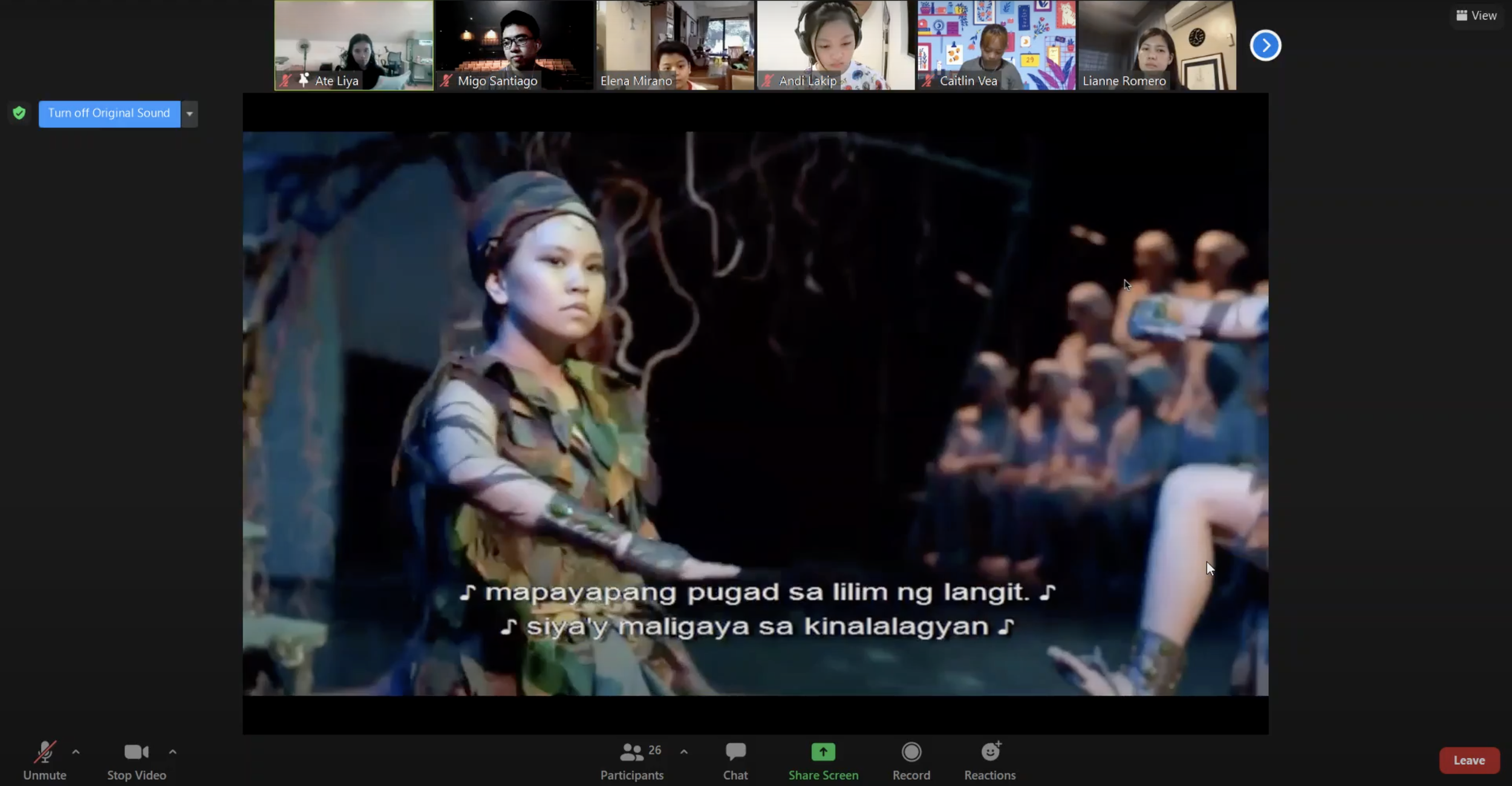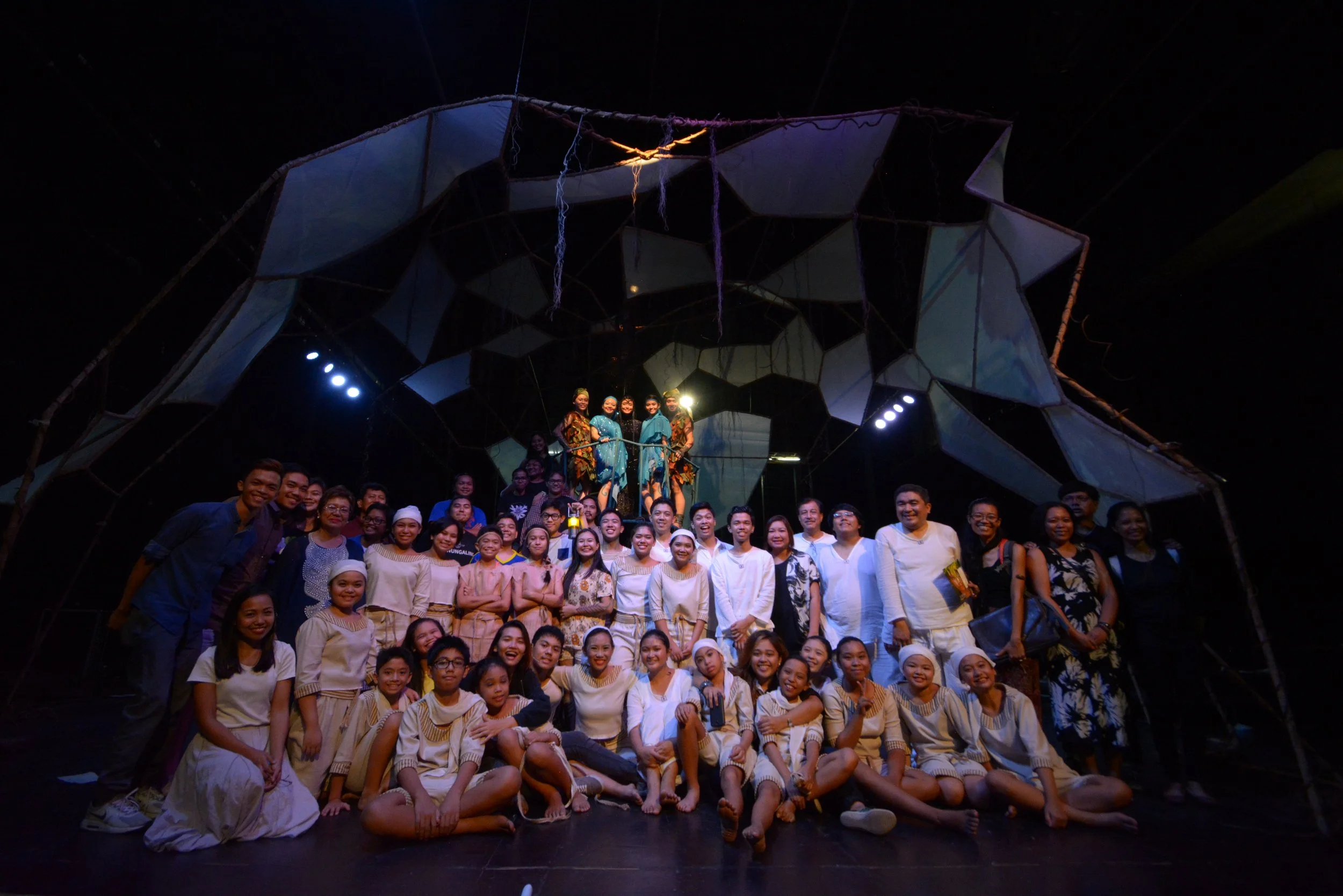Awit ni Pulau 2021: The Virtual Rebirth of a Theaterpiece
by Migo Santiago (ed. Elena Rivera Mirano)
Once upon a time…
It was the 17th of July, the year 2016. The cast had just taken their final bows for the final performance in the restaging of Awit ni Pulau, which had premiered in 1991.
The restaging cemented the place of this theater piece in the history of the U.P. Cherubim and Seraphim. 2016 had been a year filled with uncertainties. U.P. had suddenly changed its academic calendar, dislocating our schedules from all the elementary and high schools that were the source of our traditional audiences. The Faculty Center, where our regular rehearsals had been taking place, burned to a crisp on the eve of April Fool’s day. Most of us thought it would be difficult, but we knew that remounting the production would not be impossible. In the end, the show proved itself a huge success that all of us would treasure for the rest of our lives.
Awit ni Pulau, 2016
Immediately after the last performance, Tita Len hinted that there were plans of restaging this production. Some cast members (and even some of their parents) would have loved to see this production restaged. But the question was: when? Would we have to have to wait another 25 years to see this production performed on stage again?
Well, the answer was five years (and then some!). For me, it was worth the wait. Year 2020, 4 years after the restaging saw the world shut down because of the Covid-19 pandemic. We performers were locked in our homes. Unable to perform. So the second restaging was quite unexpected. It was not held in an auditorium on campus, like Abelardo Hall Auditorium or the University Theater Stage. It was not produced in one of the better known Metro Manila theaters like the Philamlife Theater (demolished in 2020) or in the CCP Complex nor even in a regional theater in, say, Baguio City. Instead, it is taking place in the four-cornered screens that we all have at our fingertips – laptop screens, Iphone screens, Ipad screens that have become our temporary dramatic arenas these days. But here's where things get interesting.
Almost 2 years ago, the UPCS website was launched to the public. There were videos of the 1991 and 2016 productions. But here is what caught my attention. There, again, was a caption stating that there was a plan to restage the production virtually. Now I know for a fact that restaging this production after 25 years has already been an incredible feat. But a virtual restaging? It gives you a sense that the UPCS dares to do things, way beyond its boundaries.
Tagasalaysay 1 just said (actually, sung) it best: "Hindi pa ho tapos ang ating dula."
Make no mistake. My experiences in this pandemic have led me to believe that it is next to impossible to mount a virtual musical production, let alone a virtual play or a virtual staged reading. As a proud alumnus of this choir, I realize that the UPCS continues to pull off the inevitable. Throughout the history of staging this theater piece for children, Dr. Ramon Santos and the late Ed Maranan designed the score to include audience participation. People watching the show would play bamboo instruments or speak lines in deep and poetic Filipino used by men and women of past generations. Due to the limitations of this pandemic, it is still going to happen, but differently. The parts of the score may have to change, but its story remains the same.
The 8th day of March. 2021. Beginning of the third production.
A rebirth was about to begin.
Eudenice Palaruan, the music director of our 2016 restaging, wanted to remount “Awit ni Pulau” the final recital requirement for his Doctor of Musical Arts (DMA) degree. Concert halls and theaters were all closed. Public performances were prohibited.
We all met on Zoom. Some of us were veterans of the first and second stagings, but the majority were fresh faces.




In all staged musicals, all rehearsals have trained their performers to familiarize themselves with the entire piece. The score is almost 60 pages. But here's the thing. These young children were immersed in face-to-face practices. They were used to hearing one another and singing as a unified group. After more than a year of no physical concerts and rehearsals, you can only imagine how they would retain the sense of singing normally. We struggled through the first days of (Zoom) rehearsals. Some of us had problematic internet connections, there were meeting lags, and all typical difficulties that you would encounter in online meetings. The question that would come to my mind was: how will these children get to memorize this masterpiece under such limited circumstances and a very short timeframe?
The answers became clear after a while. First, these children, who had been trained in the discipline of choral singing, relied on the musical knowledge and score reading skills they had learned with the group. We could rely on them to self-study. It helped lessen the load not only on the conductors but on themselves as well.
More than two months were allotted solely to learn the parts where the ensemble (or the koro) sings. Most rehearsals went into breakout rooms. It all looked like the summer camps we held in earlier years, specifically in San Luis, Batangas. Tita Len would tell all three groups/voices to spend the afternoon practicing their parts. After that, all three groups come together to sing together.
I was one of the group leaders that led one of the small groups of children in learning their music. There were days that I had a mixture of sopranos and altos per breakout room. As the days went by, those breakout rooms became segregated by voice. In those breakout rooms, a lot of things were going on. But the main thing here was our patience got tested, not only by the children but also by the internet connections and the problematic Zoom technology available.
Since rehearsals only lasted for an hour and a half (just like the live, physical rehearsals we had before CoViD), I had to practice with every individual in my group as much as possible. Even Tita Len told us we should not linger on the songs because after a little correction, the kids would work it out for themselves. We needed to move on to the other songs so these young children would be able to grasp the work as a unified form. They would get used to the same notes while singing their parts.
Yes, some of the kids still felt the terror of singing alone. There were some times that they didn't notice it. But it's that fear within the self that one might make a mistake. Some even got angry at themselves because they had difficulty hitting the notes right after several repeated attempts. Well, that is the purpose of rehearsals. It's the place where faults happen and are immediately corrected by the director. When you are all together, it is easier. It's the place where committed individuals strive for perfection and excellence. But when you are stuck home alone, the power of the ensemble around you is not there. As the journey of the children progressed, they found ways to handle standing completely alone without experiencing any fear.
While most of them continued to practice their parts, the rehearsals for soloists got underway. While we should never underestimate the importance, power and unity of the ensemble (the koro) and honestly, they had more exposure than the soloists/characters, nevertheless, these special characters still carry weight in propelling the story's narrative. Despite the absence of a physical audience the focus would still be on the individual characters.
At first, I had no idea how this project would turn out. Mounting a virtual theater piece like Awit ni Pulau is not the same as preparing for a virtual concert like the Carillons a Musique series or the Aurea Carmina. It is way more complicated than that. As Tita Len notes, it is a landmark choral work for children. A theatrical piece has a unique type of treatment, compared to just a single song. As the weeks went by, some things became evident.
After music rehearsals came the audio recording phase. In live theater, the instrumentalists accompany the singers/actors, who take the lead in establishing rhythm and the movement of a song. But it's the other way around in virtual production. The singers/actors will have to rely on the instrumentalists, with the guidance of the conductor. The accompaniment serves as the foundation for the entirety of the story's progression. Since it is still pandemic season, only a few soloists were requested to go to a recording studio. The rest had to record their voices from their homes.
Every week, the koro was given certain songs to record. It was a struggle for them because their singing must be as dry as possible. They had to find a place where the sound was clean, and had a decent ambience/ambiance. There were even days that some people kept recording their voices after midnight because there was so much noise from the outside. Many felt like they didn't sound good singing alone inside a closet or a bathroom where the sounds from outside did not intrude.
Some of them got bored, while others got bummed out. Some actually cried themselves to sleep in frustration. Tita Len made sure that they were aware of the limitations of their space and time. On the other hand, it was also a struggle for the older performers who were requested to work in the recording studio. The safety of every one of them was at risk due to the rising CoViD variant cases. The recording studio's sound engineer got his health monitored because he experienced severe fever, hoping it was not a CoViD case. Because of this, one soloist's recording session had to be canceled and he had to settle for a home recording like the younger soloists. Part of the recording period occurred when the government implemented a two-week enhanced community quarantine (ECQ) to prevent the highly transmissible Delta variant and other variants of concern from spreading.
As in the 2016 restaging, this production also went into hiatus to give way to another major UP Cherubim and Seraphim project - the 50th Anniversary “Aurea Carmina” concert. At the very end of the concert, we gave the audience an easter egg about “Awit ni Pulau,” announcing to the public that this other production was underway.
Watch the Awit ni Pulau (2021) Teaser
Then, we entered the crucial video recording and editing phase. The soloists had to improvise their costumes, lighting, props, make-up, and hairstyle from home, using what was available. The Punong Koro had to keep pace with the music while they were recording their parts in their secluded rooms and spaces. They were also instructed not to wear any accessories like watches, earrings, and even glasses. Honestly, have you ever seen a creation of Igaddu (in the fictional prehistoric time) wearing accessories?
And now, after more than a year of learning the piece, portraying characters, recording the voices and instruments, and editing the entire thing (and don’t forget: waiting!), it was time to breathe life into a preserved masterpiece.
Watching the performance in the comfort of our own homes is a good thing because you get to see how you performed, but nothing can compare the experience on a theater stage, performing in front of a full-house audience, witnessing or being part of the grand spectacle happening in front of your very eyes, in which the 1991 and 2016 cast would agree. Those cheers and applause would signify the validation of the choir's hard work and perseverance for the last 10+ months.
And as I finish writing this lengthy story that I have kept for more than a year, from its beginning to its completion, I can proudly say this to the UPCS family:
This young generation just made history. This choir just pulled off the impossible. Again.
This journey may have come to an end, but for as long as children like those who have performed in this masterpiece continue to appreciate Pulau's story, her story and songs will never come to an end. The future generations will forever be in good hands.
So, will we ever see “Awit ni Pulau” restaged for a record fourth time in UPCS history? Maybe a new generation will take the reins of this magnum opus. Maybe this time, on a theater stage with a full house.
But for now...SAKA NA!




